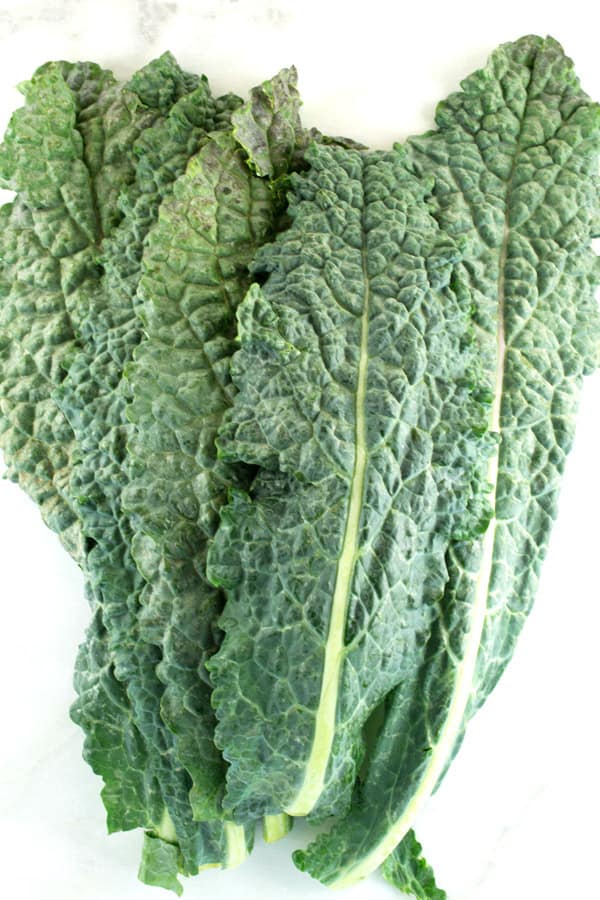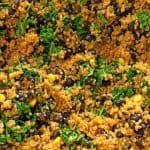This is your ultimate guide to all things kale including how to choose, store, prep, cut, cook, and preserve kale. Plus recipes, food pairings, and nutrition information.

What is Kale? Kale is a leafy green from the Brassicaceae (or Cruciferae) vegetable family. A descendant of cabbage, kale can be referred to as either a brassica or cruciferous vegetable.
As old as the Stone Age, cultivated by ancient Romans and Greeks, a staple in most of Europe, and hailed for its health benefits by philosophers -- kale is prolific, hearty, and nutritious.

Kale (Brassica Oleracea acephala)
Taste and Season
Kale is a leafy green with a strong, earthy, slightly mineral taste. Sometimes it can taste mildly bitter, especially older kale. However, it does not taste spicy, peppery, or pungent.
It has a hearty, substantial chew with leaves more similar to cabbage than to lettuce.
Young leaves are small and very mild tasting. Find young leaves in a plastic clamshell in the produce section and sometimes at a farmers market.
Fall and winter, specifically October through March (for the sweetest taste).
However, kale is known for its ability to thrive in both hot temperatures and cold temperatures. It can even survive a frost. And, surprisingly, it tastes even sweeter after a frost.
Because it is such a hearty plant, it can be harvested year round in some places. I'm sure there is a farm harvesting kale every month somewhere in the United States.
Kale Nutrition
Brassicas are some of the healthiest foods on earth. They contain many vitamins and minerals our bodies need. They also have phytochemicals that help prevent cancer, reduce inflammation, and detox the liver.

Some of the Health Benefits of Kale
Per calorie, kale has more iron than beef and more calcium than milk1.
It is rich in antioxidants, fiber, and glucosinolates (phytochemicals that reduce the risk of cancer).
Vitamins: vitamins A, B1 (thiamin), B2 (riboflavin), B3 (niacin), B6 (pyridoxine), B9 (folic acid), vitamin C, vitamin E, and vitamin K
Minerals: calcium, copper, iron, manganese, magnesium, phosphorus, and tryptophan
Other Compounds: carotenoids, flavonoids, glucosinolates, fiber, omega-3 fatty acids, protein, and chlorophyll
What to Look For
Buy kale from a farmers market if you can. Farmers market produce has often been harvested the previous day. You will have the best chance to get ultra-fresh kale if you buy from a local farmer.

However, if you buy kale from a grocery store, follow these guidelines.
- Choose kale with strong, crisp, moist, and fresh looking green leaves.
- Avoid wilted, droopy, slimy, yellow leaves, brown spots or extremely tough kale.
How to Store

- Remove any ties or bands from the leaves.
- Wrap the loose leaves with a paper towel* to absorb moisture . (See note below.)
- Place the paper-towel wrapped leaves in a plastic bag and store it in the refrigerator.
- Use fresh kale within 2 or 3 days for best results.
*Note: if you want to be more environmentally friendly, wrap the leaves in a cotton tea towel and store the kale in a fine mesh polyester bag. Wash and reuse the towel and bag.
How to Refresh

To refresh somewhat wilted leaves, soak the leaves in cold water for about 15 minutes.
How to Prep
Leafy greens may contain dirt in the leaves or near the stem. Wash the leaves thoroughly, either before or after you cut them.

How to Wash Kale - 2 Methods
Wash-Then-Cut Method:
- Wash each leaf separately under running water. Take care to wash the center stem area where dirt accumulates.
- Rub the center stem with your thumb to remove the dirt if necessary.
- Cut the clean leaves.
Cut-Then-Wash Method:
- Cut the stem out of each leaf (see how to cut it below).
- Cut the kale into ribbons.
- Place the ribbons in a bowl of water.
- Swish the ribbons around with your hands or a wooden spoon to loosen any dirt.
- Lift the kale out of the water and into a colander. Don’t dump the dirty water out with the kale or the dirt will end up back on the kale again.
- Repeat if dirt remains.
- Do a final rinse under running water.
- Use a salad spinner to dry the ribbons.
Read more about how to prepare kale.
How to Chop Kale -- 2 Methods
Method #1
Use this method if kale leaf is attached along the stem with no break.

Step 1: Fold kale in half vertically to expose the thick stem.
Step 2: Use a sharp chef’s knife to cut the stem away from the leaves. Start at one end of the stem and move to the other end.
Step 3: Open the kale up. It should look like an upside down triangle was cut from the middle of the leaf where the stem used to be.
Step 4: Fold the kale in half.

Step 5: Cut fine strips from the kale to make thin ribbons.
Method #2
Use this method if the curly leaves are not attached the length stem without breaks. There may be areas on the stem where there is no leaf attached.

- First, hold the kale upside down by the stem.
- Begin at the stem end and pull the individual leaves off the kale.
- Continue to pull all leaves off the stem.
- Tear the leaves into bite sized pieces. If any pieces are especially large, cut into ribbons with knife and cutting board.
Cooking Kale
Eat Raw in Salads

- Wash and cut kale
- Massage kale: Place 2 cups of kale and one tablespoon of olive oil in a zip top bag. Next, massage olive oil into the kale pieces for two the three minutes. Finally, let the kale rest for 15 minutes. (This will soften the leaves.)
- Add the kale and the rest of the salad ingredients to a bowl and toss.
- Drizzle vinaigrette or salad dressing over the top.
Wilt or Sautè

- Place 1 tablespoon olive oil to a frying pan and turn heat to medium low.
- Add 1 clove of minced garlic to the hot pan. Stir and cook for 1 minute. Don’t let it burn!
- Add 3 cups of washed and cut kale to the pan, a little at a time until it all fits.
- Turn it with a wooden spoon to coat it in oil and mix the garlic.
- Add 1 tablespoon of water and continue to stir, cooking for 5 to 7 minutes, or until kale begins to wilt and soften. Add more water if the kale is sticking to the pan.
- Season with salt and red pepper flakes.
- Remove the pan from the heat. Cover it with a lid and let the kale continue cooking off heat for another 3 to 4 minutes, or until soft.
Braise
- Place 1 tablespoon olive oil in a frying pan and turn heat to medium low.
- When the pan is hot, add 3 cups of kale a little at a time until it all fits in the pan.
- Stir with a spoon to coat with olive oil.
- Cook for 5 to 7 minutes, until the kale begins to wilt and soften.
- Add 1 cup of vegetable or chicken broth and a splash of fresh lemon juice.
- Cover and bring it to a boil.
- After it boils, reduce heat and cook covered for 10 to 15 minutes, until kale softens.
Stir Fry
- Add near the beginning of your stir fry to allow the kale to cook long enough to soften.
Use in Soup
- Add to soups during the last 10 to 15 minutes of cooking.
Roast
To roast kale chips:
- Preheat oven to 300° Fahrenheit.
- Wash kale, remove thick stem and tear into medium sized pieces.
- Add 1 tablespoon of olive oil to 3 cups of kale pieces.
- Stir to coat.
- Lay the pieces in a single layer on a baking sheet.
- Sprinkle with your favorite salt.
- Roast in the oven 8 to 10 minutes.
- Stir or flip the leaves and continue roasting another 5 to 8 minutes, or until the kale is crispy. It will look dehydrated, but should not be brown, black or burned.
- Remove from oven and allow to cool.
- Store in an airtight container for up to 2 days.
Steam

- Place kale in a steamer pot and steam for 10 to 15 minutes, or until it is soft.
Blanch

- Boil a large pot of water.
- Wash kale, remove the main stem, and cut in ribbons.
- When the water is boiling, add the ribbons.
- Cook for 2 to 3 minutes.
- Remove the kale from the water and place it in a colander.
- Run cold water over the leaves to stop the cooking and cool it down.
- Let the kale drip dry, or dry with a cotton tea towel.
- Place it in an airtight container in the refrigerator.
Use within 2 to 3 days.
Read more about the best ways to cook kale.
Leftovers
Cool cooked kale completely before storing it in an airtight container and refrigerating. This will help prevent that sulfur smell you may get when you open leftovers the next day.
Refrigerate leftovers for up to two days.
How to Preserve
Freeze the Leaves

- Blanch and dry the kale.
- Spread the ribbons/leaves out on a baking sheet.
- Place the baking sheet in the freezer and quick freeze for 1 hour.
- After 1 hour, remove the baking sheet from the freezer. Immediately place the kale in a freezer bag and return to the freezer.
Quick freezing the kale will prevent the leaves from sticking together when they freeze. You can then remove only the amount you need, rather than thawing the whole bag.

Label and be sure to include the date. Frozen kale can keep in the freezer for 1 to 2 months.
Kale Recipes
Substitutions
Substitute collards or mustard greens for kale in cooked kale recipes.
Mix a variety of leafy greens together in salads with kale or in place of kale.
What Foods Pair With Kale?
This list is not complete, as many foods taste good with this hearty green. However, these are the most common and most flavorful foods that pair well with it:
- Olive oil, garlic, and salt
- Spinach
- Sausage
- Bacon
- White beans
- Black beans
- Quinoa
- Chicken
- Eggs
- Onions
- Potatoes
Varieties
There are many, many varieties of kale. They all have similar nutrition benefits. Use any variety interchangeably in recipes.
These are the most common varieties you will find in farmers markets and grocery stores:

- Tuscan kale (also known as Lacinato, dinosaur, or Italian): Long, flat, puckered and wrinkled leaves. Leaf color is very deep dark green. It is easier to chew it when it is raw. The leaf is often one continuous leaf attached to the stem.

- Curly kale: Bulky, thick, with wrinkly/curly leaves. Leaf color is bright green or lighter green. It can be a more rough chew when it is raw.

- Red Russian kale: Broad leaf that usually wrinkles on the tip. The stem, ribs, veins, and leaf edges are bright purple or magenta.
In my experience, younger leaves taste better. Red Russian kale that is too old is the bitterest kale variety I have personally tasted.
Give kale a try if you have never eaten it. It is one of the healthiest things you can do today!

Did you make a kale recipe? Don't forget to tag @thetastytip or #thetastytip so I can see it.
Comment below and let me know how you like to eat kale.






Comments
No Comments